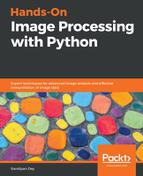Thresholding refers to a family of algorithms that use a pixel value as a threshold to create a binary image (an image with only black-and-white pixels) from a grayscale image. It provides the simplest way to segment objects from a background in an image. The threshold can be chosen manually (by looking at the histogram of pixel values) or automatically using algorithm. In scikit-image, there are two categories of thresholding algorithm implementations, namely histogram-based (a pixel intensity histogram is used with some assumptions of the properties of this histogram, for example bimodal) and local (only the neighboring pixels are used to process a pixel; it makes these algorithms more computationally expensive).
In this section, we shall only discuss a popular histogram-based thresholding method known as Otsu's method (with the assumption of a bimodal histogram). It computes an optimal threshold value by simultaneously maximizing the inter-class variance and minimizing the intra-class variance between two classes of pixels (which are separated by that threshold value). The next code block demonstrates an implementation of Otsu's segmentation with the horse input image and computes the optimal threshold to separate out the foreground from the background:
image = rgb2gray(imread('../images/horse.jpg'))
thresh = threshold_otsu(image)
binary = image > thresh
fig, axes = pylab.subplots(nrows=2, ncols=2, figsize=(20, 15))
axes = axes.ravel()
axes[0], axes[1] = pylab.subplot(2, 2, 1), pylab.subplot(2, 2, 2)
axes[2] = pylab.subplot(2, 2, 3, sharex=axes[0], sharey=axes[0])
axes[3] = pylab.subplot(2, 2, 4, sharex=axes[0], sharey=axes[0])
axes[0].imshow(image, cmap=pylab.cm.gray)
axes[0].set_title('Original', size=20), axes[0].axis('off')
axes[1].hist(image.ravel(), bins=256, normed=True)
axes[1].set_title('Histogram', size=20), axes[1].axvline(thresh, color='r')
axes[2].imshow(binary, cmap=pylab.cm.gray)
axes[2].set_title('Thresholded (Otsu)', size=20), axes[2].axis('off')
axes[3].axis('off'), pylab.tight_layout(), pylab.show()
The next screenshot shows the output of the previous code block; the optimal threshold computed by Otsu's method is marked by a red line in the histogram as follows:

